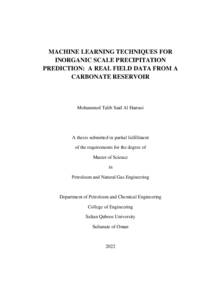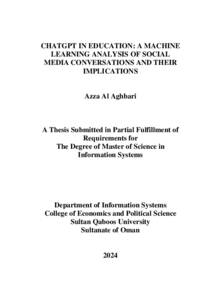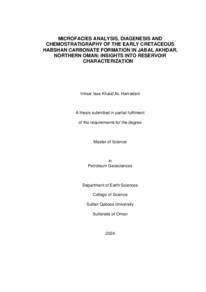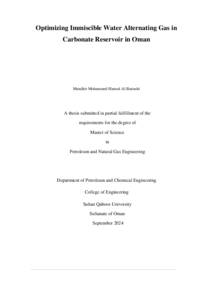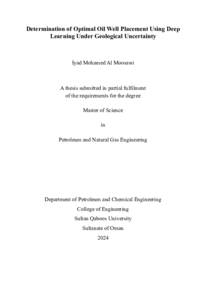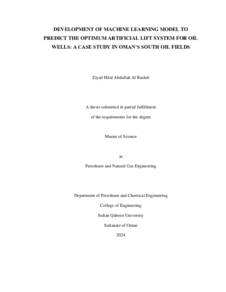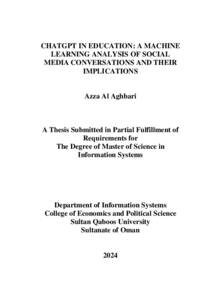Document
Machine learning techniques for inorganic scale precipitation prediction : a real field data from carbonate reservoir.
Publisher
Sultan Qaboos University.
Gregorian
2022
Language
English
English abstract
The precipitation of inorganic scales in the oil and gas industry has been identified as
a major issue for flow assurance and the optimization of oil and gas fields due to the
damage that these precipitations can cause in reservoirs, well completions, and surface
facilities. On the other hand, predicting these precipitations has always been
challenging for engineers of petroleum, production, and production facilities.
Although many commercial computer programs in the industry can predict inorganic
scale precipitations with some accuracy, the majority have many limitations that can
negatively impact prediction performance.
Machine learning (ML) has received substantial attention in the oil and gas industry in
recent years. The purpose of this study is to investigate the use of machine learning
algorithms as a new approach to predicting inorganic scale precipitations in oil and
gas carbonate formations.
The methodology of the current study consists of gathering input and output data, such
as pressure, temperature, artificial lifting type, target formation, water ionic
composition, pH, TDS, and whether or not each well tends to precipitate the inorganic
scale. The algorithms chosen for prediction are Naive Bayes (NA), Neural Network
classifier (NN), Logistic Regression (LR), Random Forest (RF), Decision Tree (DT),
Support Vector Machine (SVM), and K-Nearest Neighbors (KNN), and they will be
evaluated based on accuracy and other classification performance metrics.
The results of the models show that SVM, DT, and KNN are the best classifiers in
terms of prediction accuracy scores with around 83%. Furthermore, a decision tree
chart was created based on the Decision Tree (DT) model and can be used to examine
the scale precipitation tendency for any future water sample. The chart is validated
using real well cases from the same field, demonstrating a match between the predicted
class (the well possesses or does not possess a high potential to precipitate inorganic
scale) and the data collected in the well's interventions history reports. Based on the
DT model, the artificial lifting method, target formation, pressure at the pump depth,
and SO4
2-
, HCO3
-
ionic compositions are found to be the strongest features that play
a significant role in the scale precipitations in the studied field.
Implementing the proposed model will lead to many benefits, including properly
employed well intervention resources, reduced oil deferment due to pump failures
caused by scale precipitation, and reduced budget overspending entailed by
unexpected failures in pumps, valves, or even surface facilities.
Member of
Resource URL
Arabic abstract
دائما ما كانت تشكل الترسبات الغير عضوية في صناعة النفط والغاز تحدي كبير لعمليات ضمان التدفق من المكمن النفطي إلى مرافق المعالجة وكذلك لعمليات تحسين الأنتاج في حقول النفط والغاز وذلك نظرا لللاضرار التي تسببها هذه الترسبات سواءا على المكامن الحاوية للهيدروكربونات أو إلكمالأت الأبار أو حتى للمرافق الموجودة على السطح. من جانب أخر التنبؤ بهذه الترسبات كانت على الدوام مهمة بها تحدي كبير لمهندسي البترول ومرافق الأنتاج. على الرغم من توفر عدد من برامج الكمبيوتر التجارية والتي لها القدرة على التنبؤ بالترسبات الغير عضوية بقدر من الدقة إلا أن أغلب هذه البرامج بها عدد من القيود وجوانب من القصور التي يمكن أن تؤثر بشكل سلبي على مدى صحة التنبؤات. نظرا ألن مفهوم تعلم الألة قد حظي بإهتمام كبير في صناعة النفط والغاز في السنوات الماضية وتعزيزا لهذا الأهتمام فأن هدف هذه الدراسة هو النظر إلمكانية إستخدام خوارزميات التعلم الألي كنهج جديد للتنبؤ بالترسبات الغير عضوية في مجال انتاج النفط والغاز. بدأت منهجية الدراسة بجمع بيانات المدخالت والمخرجات أمثال الضغط والحرارة ونوع الرفع الصناعي المستخدم والطبقة المستهدفة وتكوين الماء الأيوني ومقدار الرقم الهيدروجيني ومقدار مجموع المواد الصلبة الذائبة وما إذا كان البئر النفطي الغازي يميل لتكوين ترسبات أو ال. الخوارزميات المختارة للتنبؤ هي Naive Bayes (NA), Neural Network classifier (NN), Logistic Regression (LR), \Random Forest (RF), Decision Tree (DT), Support Vector Machine (SVM), and K- ,(KNN (Neighbor Nearest وتم تقييمها بناءا على دقة التنبؤ وعدد أخر من مؤشرات قياس أداء التصنيف الأخرى. تظهر نتائج الدراسة أن النماذج KNN and ,DT ,SVM هي أفضل الخوارزميات المستخدمة من حيث تحقيقها درجات دقة تنبؤ أعلى. بناءا على ذلك تم إنشاء مخطط شجرة القرار إعتمادا على نتائج نموذج ال Tree Decisionوالذي يمكن استخدامه لفحص قابلية الترسب من عدمه ألي عينة من أي بئر نفطي مستقبال. المخطط تم التحقق من صحته بإستخدام معلومات حقيقية من آبار قائمة في نفس الحقل المستهدف بالدراسة. اذ وضحت النتائج تطابق بين نوع التنبؤات الناتجة من المخطط والبيانات المسجلة في تقارير تاريخ صيانة الأبار. خلصت الدراسة كذلك انه بالاعتماد على نموذج ال Tree Decision فإن نوع الرفع الصناعي المستخدم والطبقة المستهدفة و مقدار الضغط عند عمق المضخة و التكوين الأيوني للكبريتات والبيكربونات )كربونات الهيدروجين( تشكل أهم العناصر التي تلعب الدور الأكبر في عملية الترسب في الحقل المستهدف بالدراسة. استخدام المخطط المقترح سيؤدي لعدد من الفوائد منها التوظيف الأمثل لمعدات صيانة الأبار وتقليل الفاقد من النفط الناتج عن أعطال مضخات الرفع الصناعي وكذلك خفض الأنفاق الزائد من الميزانية بسبب الأعطال غير المتوقعة في المضخات و الصمامات أو المرافق الموجودة على السطح.
Category
Theses and Dissertations

